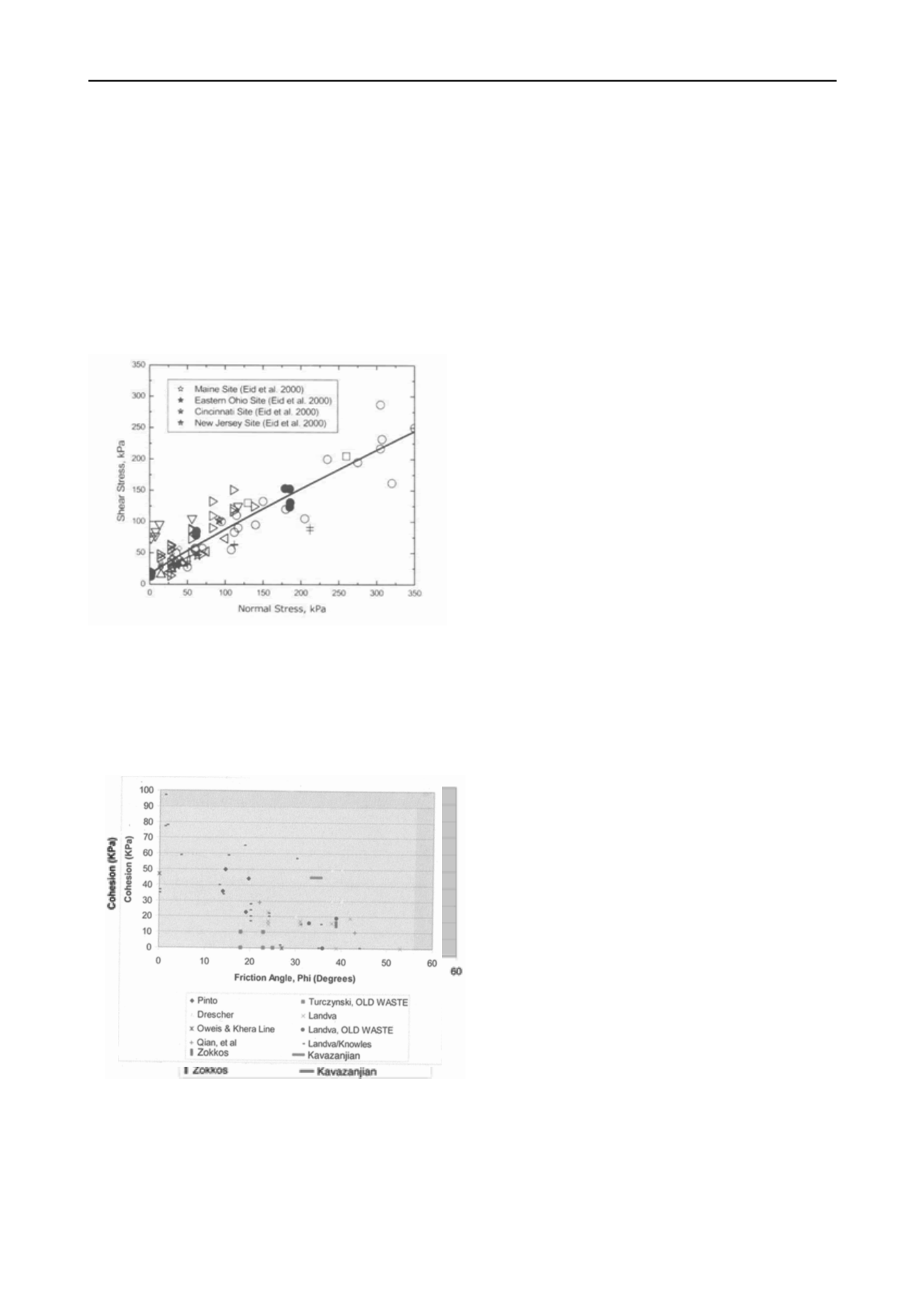
3074
Proceedings of the 18
th
International Conference on Soil Mechanics and Geotechnical Engineering, Paris 2013
calculationed data from case histories and in-situ testing than
they did on laboratory data. Kavazanjian adopted a bilinear
representation of the MSW shear strength using Mohr-Coulomb
parameters. Their data suggested that up to the normal stress of
30 kPa no increase in the shear strength was noted.
Accordingly, they suggested that at normal stress below 30 kPa,
the Mohr-Coulomb parameters were Φ = 0 and
c
= 24 kPa, and
above normal stress of 30 kPa, the parameters were
c
= 0 and Φ
= 33°. More recently, Kavanzanjian, 1999, Zekkos, 2005, and
Bray et al., (2009), have characterized shear strength properties
by proposing Mohr-Coulomb strength envelopes derived from
their experimental data (Fig. 1).
Figure 1 Recommended static shear strength of MSW based
primarily on direct shear tests and field observation of slope stability.
Bray et al. (2009)
Still others reported results in terms of the same parameters
after obtaining data from back calculations of failed landfills
(Kavazanjian, 2001, Eid, et al. 2000). Figure 2 presents data
from various sources.
Figure 2 Lab Test or Institute Testing on MSW
Other researchers believed the variability they observed in their
samples was too great for Mohr-Coulomb parameters to be usefully
developed for each sample tested (Siegel, et al., 1990). For example,
Siegel, et. al, (1990) tested samples from the OII landfill, perhaps the
most studied landfill, in Monterey Los Angeles area and made the
observation that given the refuse variability, deriving Mohr-Coulomb
angles of internal friction and cohesion intercepts for individual samples
was inappropriate. Singh and Murphy (1990) suggested that
Mohr-
Coulomb’s theory might not be applicable to characterizing the
shear strength of MSW.
The cause of this controversy is that while shearing, the
strength mobilization rates for MSW and soils are quite
different. The MSW behaves as a strain hardening material,
i.e., even at large shear strains, it will continue to mobilize
additional shear stress without exhibiting a leveling off or drop
in shear stress or developing a failure plane typical of soils. In
limit equilibrium analyses, such as what is used in slope
stability analysis, the basic assumption is that the peak strength
mobilization occurs at the same time along the entire failure
surface. Because of the incompatibility of strains at which peak
strength is mobilized in MSW, in soils, and along liner
interfaces, the limit equilibrium analyses need to use reduced
shear strength of MSW or the residual strength of soil and the
interfaces (Mitchell et al. 1995).
3 COHESIVE PROPERTIES OF MUNICIPAL SOLID
WASTE
The shear strength of the MSW is similar to a soil in many
ways. It can be thought of for conceptual purposes (and many
argue for other purposes as well) as a fibrous soil (Zekkos,
2008). Direct shear tests by Landva and others have shown that
the shear strength of MSW depends on the nature of the test
(Qian et al., 2002).
MSW can exhibit a kind of behavior while shearing, which
is typically cohesion, but is seen by others as only apparent
cohesion. Some call this apparent cohesion-‘adhesion’ (Qian et.
al., 2002). This behavior comes about mainly because MSW is a
hodgepodge of different materials with different shapes. The
interlock of these odd-sized ‘grains’ causes the MSW to exhibit
behavior similar to what is called cohesion in clay soils. In clay,
cohesion is the result of water and associated electrical charges,
although the critical state concept considers cohesion even in
clays resulting from interlocking (Schofield, 2005). The
cohesion in the MSW is the result of mechanical interlock. As
MSW degrades with age the effect of the interlock would
decrease and the cohesion should drop. Accordingly, cohesion
in MSW cannot be treated as a constant parameter. Though, the
root cause of the behavior differs from that in soils, the
observed behavior is quite similar. Cohesion is observed in
MSW although it can be correctly termed apparent cohesion.
Cohesion has been observed in data on actual waste than in
model wastes. The cohesive behavior of MSW is also reinforced
in practice by the abundance of incidents in which vertical or
nearly vertical cuts remain stable for years without any signs of
failure (Qian et. al., 2002).
4 DATA FROM MODEL WASTE EXPERIMENTS
Testing of artificial waste and model waste provided data points
with no cohesion (Thusyanthan et al, 2004).
5 DATA FROM CASE HISTORIES
As was mentioned earlier, another method of collecting
shear strength data is back-calculations based on case histories.
In almost all of the cases, the shear strength data was obtained
after a landfill failure. The most common method was to assume
a factor of safety equal to unity and back-calculate the shear
strength of the MSW involved using standard geotechnical
analysis. In this study, only case studies using a factor of safety
equal to one for failure analysis were reported. Other case
studies estimate the factor of safety and then back-calculate
shear strength parameters. However, the shear strength values
are very sensitive to changes in the factor of safety, and the
factor of safety can’t be known with certainty unless failure
occurs. The most common details presented by the researchers,
and the techniques used to calculate the shear parameters are
given in Qian, et al., 2002 and Zekkos (2005) among others.


